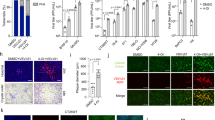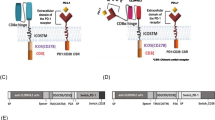Abstract
Pancreatic cancer is often fetal, and farther effective therapeutic options are needed. This study was designed to assess whether the replication-restricted herpes simplex virus, G207, was effective in killing human pancreatic cancer cells in vitro. G207, a multimutated strain of herpes simplex virus type 1 carrying lacZ reporter gene, is capable of efficient cytolytic growth in many dividing cells, including certain tumor cells, but not in nondividing cells. Three human pancreatic cell lines, AsPC-1, MIA PaCa-2, and BxPC-3, were infected with G207 at different multiplicities of infection. After 24 hours, expression of the lacZ reporter gene was tested using a histochemical X-gal assay. In addition, cell lines were infected with G207 for 24 to 48 hours; then the virus obtained from cell pellets and media supernatant was used to infect Vero cells to obtain G207 titers by plaque assay. To assess whether increasing viral immediate early gene expression would improve cytolysis and virus production, similar experiments were performed with the addition of 0.5 mmol/L of hexamethylene bisacetamide (HMBA) 1 hour after viral infection. Finally, MTS cell viability assays were performed to measure viable cells at 24 to 96 hours post infection. The X-gal assay data revealed a viral dose-dependent β-galactosidase expression, indicating G207 infectivity and expression of the lacZ reporter gene. Plaque assays demonstrated a viral dose-dependent increase in plaque formation, indicating viral production from all three cell lines. In addition, HMBA data indicated a modest increase in viral production. The MTS assay data indicated a dose-dependent cytotoxicity for G207 in the cell lines tested. G207 infects, replicates in, and is cytotoxic to the above-listed human pancreatic cell lines in vitro and warrants therapeutic evaluation in models of pancreatic cancer.
Similar content being viewed by others
References
Li Y, Hwang R, Pandit L, Gordon E, Anderson WF, Parekh D. Gene therapy of metastatic cancer with intraperitoneal injections of concentrated retroviral herpes simplex thymidine kinase vector supernatant and ganciclovir. Ann Surg 1996;224:405–417.
Link CJ Jr, Levy JP, McCann LZ, Mooreman DW. Gene therapy for colon cancer with the herpes simplex thymidine kinase gene. J Surg Oncol 1997;64:289–294.
Chen S, Shine HD, Goodman C, Grossman RG, Woo SLC. Gene therapy for brain tumors: Regression of experimental gliomas by adenovirus-mediated gene transfer in vivo. Proc Nad Acad Sci USA 1994;91:3054–3057.
Takamiya Y, Short P, Moolten FL, Fleet C, Mineta T, Breakefield XO, Martuza RL. An experimental model of retrovirus gene therapy for malignant brain tumors. J Neurosurg 1993;79:104–110.
Culver KW, Ram Z, Wallbridge S, Ishii H, Oldfield EH, Blaese RM. In vivo gene transfer with retroviral vector-producer cells for treatment of experimental brain tumors. Science 1992;256:1550–1552.
Mineta T, Rabkin SD, Yazaki T, Hunter WD, Martuza RL. Attenuated multi-mutated herpes simplex virus-1 for the treatment of malignant gliomas. Nature Med 1995;1:938–943.
Yazaki T, Manz HJ, Rabkins SD, Martuza RL. Treatment of human malignant meningiomas by G207, a replication-competent multimutated herpes simplex virus 1. Cancer Res 1995;55:4752–4756.
Chou J, Kern ER, Whidey RJ, Roizman B. Mapping of herpes simplex virus-1 neurovirulence to γ134.5, a gene nonessential for growth in culture. Science 1990;250:1262–1266.
Chou J, Roizman B. Herpes simplex virus 1 γ134.5 gene function, which blocks the host response to infection, amps in the homologous domain of the genes expressed during growth arrest and DNA damage. Proc Natl Acad Sci USA 1994;91:5247–5251.
Chou J, Chen J, Gross M, Roizman B. Association of a M,90,000 phosphoprotein with protein kinase PKR in cells exhibiting enhanced phosphorylation of translation initiation factor eIF-2α and premature shutoff of protein synthesis after infection with γ134.5- mutants of herpes simplex virus 1. Proc Nad Acad Sci USA 1995;92:10516–10520.
He B, Chou J, Liebermann DA, Hoffman B, Roizman B. The carboxyl terminus of the murine MyD 116 gene substitutes for the corresponding domain of γ134.5 gene of herpes simplex virus to preclude the premature shutoff of total protein synthesis in infected human cells. J Virol 1996;70:84–90.
Zhan Q, Lord KA, Alamo I Jr, Hollander MC, Carrier F, Ron D, Kohn KW, Hoffman B, Liebermann DA, Fornace AJ Jr. The gadd and MyD genes defines a novel set of mammalian genes encoding acidic proteins that synergistically suppress cell growth. Mol Cell Biol 1994;14:2361–2371.
Fornace AJ Jr, Jackman J, Hollander MC, Hoffman-Lieber-man B, Lieberman DA. Genotoxic-stress-response genes and growth-arrest genes gadd, MyD, and other genes induced by treatments of eliciting growth arrest. Ann N Y Acad Sci 1992;663:139–153.
Fong Y, Federoff HJ, Brownlee M, Blumberg D, Blumgart LH, Brennan ME. Rapid and efficient gene transfer in human hepatocytes by herpes viral vectors. Hepatology 1995;22:723–729.
McFarlane M, Daksis JI, Preston CM. Hexamethylene bisacetamide stimulates herpes virus immediate early gene expression in the absence of trans-induction by Vmw65. J Gen Virol 1992;73:285–292.
Tang MH, Shimano T, Chu TM. Differential localization of human pancreatic cancer-associated antigen and carcinoembryonic antigen in homologous pancreatic tumoral xenograft. J Nad Cancer Inst 1981;67:563–569.
Yunis A, Arimura GK, Russin D. Human pancreatic carcinoma (MIA PaCa-2) in continuous culture: Sensitivity to asparaginase. Int J Cancer 1977; 19:128–135.
Tan MH, Nowak NJ, Loor R, Ochi H, Sandberg AA, Lopez C, Pickren JW, Berjian R, Douglass HO Jr, Chu TM. Characterization of a new primary human pancreatic tumor line. Cancer Invest 1986;4:15–23.
Dunigan DD, Waters SB, Owens TC. Aqueous soluble tetrazolium/formazan MTS as an indicator of NADH- and NADPH-dependent dehydrogenase activity. Biotechniques 1995;19:640–649.
Technical Bulletin. Promega celltiter 96 TM AQueous non-radioactive cell proliferation assay. Promega Corp, 1993, pp 1–8.
Aoki K, Yoshida T, Sugimura T, Terada M. Liposome-mediated in vivo gene transfer of antisense K-ras construct inhibits pancreatic tumor dissemination in the murine peritoneal cavity. Cancer Res 1995;55:3810–3816.
Liu Y, Rabinovitch A, Suarez-Pinzon W, Muhkerjee B, Brownlee M, Edelstein D, Federoff HJ. Expression of bcl-2 gene from a defective HSV-1 amplicon vector protects pancreatic beta-cells from apoptosis. Hum Gene Ther 1996;7:1719–26.
Author information
Authors and Affiliations
Additional information
Supported by the Wilmot Cancer Research Fellowship Program funded by the James P. Wilmot Foundation.
Rights and permissions
About this article
Cite this article
Lee, J.H., Federoff, H.J. & Schoeniger, L.O. G207, modified herpes simplex virus type 1, kills human pancreatic cancer cells in vitro. J Gastrointest Surg 3, 127–133 (1999). https://doi.org/10.1016/S1091-255X(99)80021-3
Issue Date:
DOI: https://doi.org/10.1016/S1091-255X(99)80021-3




